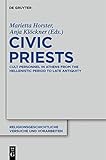Civic Priests : Cult Personnel in Athens from the Hellenistic Period to Late Antiquity / ed. by Marietta Horster, Anja Klöckner.
Material type: TextSeries: Religionsgeschichtliche Versuche und Vorarbeiten ; 58Publisher: Berlin ; Boston : De Gruyter, [2011]Copyright date: ©2012Description: 1 online resource (249 p.)Content type:
TextSeries: Religionsgeschichtliche Versuche und Vorarbeiten ; 58Publisher: Berlin ; Boston : De Gruyter, [2011]Copyright date: ©2012Description: 1 online resource (249 p.)Content type: - 9783110258073
- 9783110258080
- 292.6/109385 23
- BL795.P7 C58 2012
- online - DeGruyter
- Issued also in print.
| Item type | Current library | Call number | URL | Status | Notes | Barcode | |
|---|---|---|---|---|---|---|---|
 eBook
eBook
|
Biblioteca "Angelicum" Pont. Univ. S.Tommaso d'Aquino Nuvola online | online - DeGruyter (Browse shelf(Opens below)) | Online access | Not for loan (Accesso limitato) | Accesso per gli utenti autorizzati / Access for authorized users | (dgr)9783110258080 |
Frontmatter -- Contents -- Introduction -- Priests, priesthoods, cult personnel – traditional and new approaches -- Tradition — Repräsentation — Distinktion. Eine Fallstudie zu Reliefweihungen von Priestern im späthellenistischen und römischen Attika -- The social construction of priests and priestesses in Athenian honorific decrees from the fourth century BC to the Augustan period -- Prêtres et prêtresses d’Athènes et de Délos à travers les décrets honorifiques athéniens (167-88 a. C.) -- The tenure, appointment and eponymy of priesthoods and their (debatable) ideological and political implications -- Heidnische Priester in Attika vom dritten bis zum fünften Jahrhundert nach Christus -- Athenian civic priests from classical times to late antiquity: some considerations -- Indices
restricted access online access with authorization star
http://purl.org/coar/access_right/c_16ec
Images and inscriptions on monuments can show us how priests and cult personnel saw themselves and were viewed by others, illuminating the social and political identity of these figures within their polis. Dedications and donations by cult personnel, and the honours that they earned, demonstrate their claim on the city’s attention and their financial power. The cityscape itself came to be shaped, in varying intensities and forms, by statues in honour of cult personnel, set up by relatives, fellow citizens and other groups. This set of cultural records, analysed in the studies presented here, is central to understanding how the roles of priests and priestesses were constructed in social and political terms in post-classical Athens. The approaches are both historical and archaeological, and elucidate the religious functions that the cult personnel fulfilled for the city, and their perception, by themselves and by others, as citizens of the polis.
Issued also in print.
Mode of access: Internet via World Wide Web.
In English.
Description based on online resource; title from PDF title page (publisher's Web site, viewed 28. Feb 2023)


